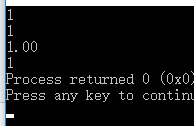PAT 1108 Finding Average [難]
1108 Finding Average (20 分)
The basic task is simple: given N real numbers, you are supposed to calculate their average. But what makes it complicated is that some of the input numbers might not be legal. A legal input is a real number in [−1000,1000] and is accurate up to no more than 2 decimal places. When you calculate the average, those illegal numbers must not be counted in.
Input Specification:
Each input file contains one test case. For each case, the first line gives a positive integer N (≤100). Then N numbers are given in the next line, separated by one space.
Output Specification:
For each illegal input number, print in a line ERROR: X is not a legal number
X is the input. Then finally print in a line the result: The average of K numbers is Y where K is the number of legal inputs and Y is their average, accurate to 2 decimal places. In case the average cannot be calculated, output Undefined instead of YK is only 1, output The average of 1 number is Y instead.
Sample Input 1:
7
5 -3.2 aaa 9999 2.3.4 7.123 2.35
Sample Output 1:
ERROR: aaa is not a legal number
ERROR: 9999 is not a legal number
ERROR: 2.3.4 is not a legal number
ERROR: 7.123 is not a legal number
The average of 3 numbers is 1.38
Sample Input 2:
2
aaa -9999
Sample Output 2:
ERROR: aaa is not a legal number
ERROR: -9999 is not a legal number
The average of 0 numbers is Undefined題目大意:給出n個數,可能不是合法的,給出那些合法的數的平均值。
//我的天哪,這個題也太難了吧,難死我了,改了好多遍我為什麼就是寫不對?越改通過的測試點越少。。絕望。
#include <iostream> #include <algorithm> #include<cstdio> #include<stdio.h> #include <queue> #include<cmath> #include <vector> #include<set> using namespace std; //float toNum(string s){ // //有小數怎麼辦?有點絕望,好像沒有做過這樣的題目。 // int pos=s.find("."); // float num=0; // for(int i=0;i<pos;i++){ // num=num*10+(s[i]-'0'); // n=atof() // } // //} int main() { int n; cin>>n; string s; vector<float> legal; vector<string> nolegal; for(int i=0; i<n; i++) { cin>>s; bool flag=true; for(int j=0; j<s.size(); j++) //判斷是否是字母 { if(!(s[j]>='0'||s[j]<='9')||s[j]!='.'||!s[j]!='-')//只能是這幾種。 { flag=false; break;//比如2..0這樣的算是合法數字嗎?這就很尷尬,我感覺不是。 } if((s[j]=='-'&&j)|(s[j]=='-'&&j==0&&s.size()==1)){//加上這個,並沒有通過1和4測試點。 flag=false;break; } } if(s.find(".")!=string::npos) { int pos=s.find("."); if(s.size()-1>3||pos==0)//如果小數點出現在第一個也是不合法的,加上這個之後還是沒通過14測試點。 { flag=false; } if(s.find(".",pos+1)!=string::npos) { flag=false; } } float numf; if(flag) { numf=atof(s.c_str()); if(numf>1000.0||numf<-1000.0) { nolegal.push_back(s); } else { legal.push_back(numf); } } else { nolegal.push_back(s); } } for(int i=0; i<nolegal.size(); i++) { printf("ERROR: %s is not a legal number\n",nolegal[i].c_str()); } if(legal.size()==0) { printf("The average of 0 numbers is Undefined"); } else if(legal.size()==1) { printf("The average of 1 number is %.2f",legal[0]); } else { float sum=0; int size=legal.size(); for(int i=0; i<size; i++) sum+=legal[i]; printf("The average of %d number is %.2f",size,sum/size); } return 0; } //1,沒有判斷-是否在首位,如:1-6就視為合法了。。 //2.只有一個.時,是不合法的。。 //3.測試了-,發現自己的程式碼認為是合法的。。。絕望,好複雜。。。 //4.發現了要給十分嚴重的問題,就是如果它的非法輸入不一定非得是字母。。。
//我也不知道這是為什麼通不過。。。哭遼。
學習了柳神的程式碼:

參考:https://www.cnblogs.com/lanjianhappy/p/6861728.html
sscanf(輸入的字串,格式,輸出到);
scanf是從鍵盤輸入,而sscanf讀入的是第一個引數,是個字串。
發現這裡第三個引數根本就沒有型別限制!!!
Int sscanf( string str, string fmt, mixed var1, mixed var2 ... ); int scanf( const char *format [,argument]... );
char buf[512] = ; sscanf("123456 ", "%s", buf); printf("%s/n", buf); 結果為:123456
sscanf("123456 ", "%4s", buf); printf("%s/n", buf); 結果為:1234
sscanf("123456abcdedfBCDEF", "%[1-9a-z]", buf); printf("%s/n", buf); 結果為:123456abcdedf
就是類似於正則表示式!
sprinf()學習:http://www.runoob.com/cprogramming/c-function-sprintf.html
C 庫函式 int sprintf(char *str, const char *format, ...) 傳送格式化輸出到 str 所指向的字串。
#include <stdio.h> #include <math.h> int main() { char str[80]; sprintf(str, "Pi 的值 = %f", M_PI); puts(str); return(0); } Pi 的值 = 3.141593
應該是從後往前看,先將第三個引數第二個引數的格式賦值,然後再整體賦值給第一個引數。
當然第一個引數和上一個函式一樣都是字串。
int main() { string s; char a[50]; float temp; cin>>s; sscanf(s.c_str(),"%f",&temp); sprintf(a,"%.2f",temp); cout<<s<<'\n'; cout<<a<<'\n'; cout<<temp; return 0; }

學習了!
柳神的程式碼真的是太厲害了。

多複習!
